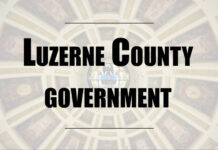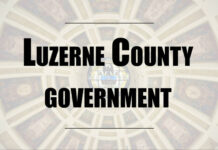Luzerne County’s Government Study Commission will decide in two weeks if it will recommend the election of some county council members by regional districts, the seven commission members agreed Thursday.
Currently all 11 council members are elected countywide, or at-large.
No commission members support fully switching to districts, which means the choice would be a district/at-large combination or no districts.
A commission majority has supported switching from 11 to seven council members.
The commission has been meeting regularly to assess potential county home rule charter changes and aims to place its proposal on the November 2025 ballot. Voters will then decide whether to switch to the new structure or keep the system in effect since January 2012.
The commission’s next meeting is Feb. 20.
Districts were discussed Thursday because commission Secretary Ted Ritsick presented exploratory maps envisioning three, four, five and seven districts that he compiled with assistance from the county’s GIS/Mapping Department and Election Bureau.
Posted on the commission section at luzernecounty.org, the maps include the potential number of registered voters and their political party affiliations, total population and municipalities in each zone.
Commission member Mark Shaffer said he supports keeping all council members at large and sought a prompt vote to “put this to bed.”
Commission member Stephen J. Urban said he appreciates Ritsick’s work on the maps but is still “120,000%” against districts. He asserted the addition of some districts would put an unnecessary burden on the election bureau and “convolutes this entire process.” Urban said candidates from throughout the county have been elected to council, including the southern half, and predicted districts would be rejected by voters and are a “waste of time.”
“I think you’re going down a rabbit hole that’s unnecessary,” Urban said.
Commission Treasurer Cindy Malkemes said she agrees with Urban.
Ritsick said he does not think adding some districts would “be the death” of the commission’s proposal and said he believes voters in some regions, such as the growing Hazleton area, would support institutionalizing a council seat from their area. He said Urban raised some reasonable concerns but believes those issues could be resolved by the commission.
Commission Vice Chairman Vito Malacari said he has not reached a final decision but believes more than seven council members are warranted if districts are added to the mix.
Critics have argued an 11-member council is less efficient, but charter drafters chose a larger council so more people would be involved in decisions. Those seeking approval from council must convince a majority of at least six.
Commission member Matt Mitchell said he has contemplated arguments for and against districts and is leaning toward keeping all council seats at-large, although he remains open to both options.
Commission Chairman Tim McGinley said he also is more supportive of sticking with an all at-large council and said he agrees with Malacari that there should be more than seven council members if a majority wants to add several districts.
Ritsick was advocating three or four district seats with a council of seven.
During public comment, Plains Township resident Gerald Cross, who had served as a consultant for drafters of the current charter, said districts were rejected because the county exists to uniformly provide services to residents throughout the county. He said his concern is similar to that of reducing the size of council, saying smaller doorways limit which people get through, which may not be in the county’s best interest.
Reach Jennifer Learn-Andes at 570-991-6388 or on Twitter @TLJenLearnAndes.




